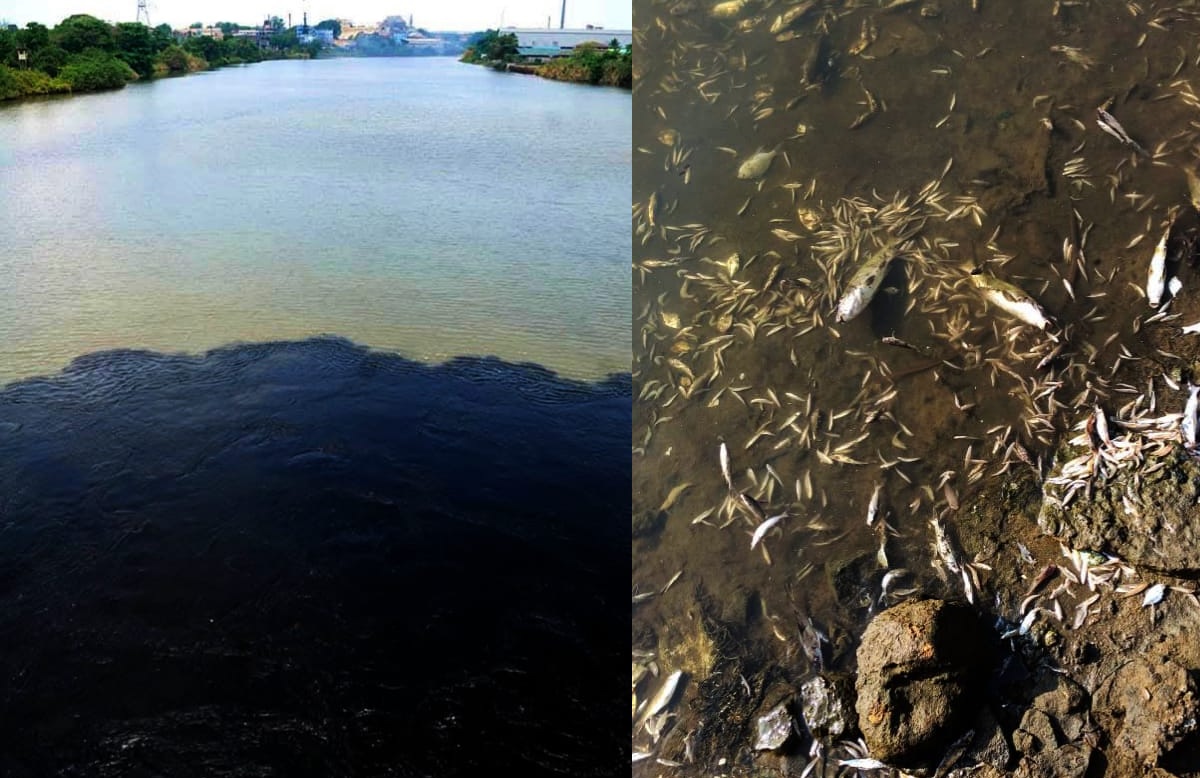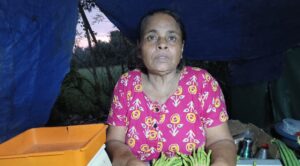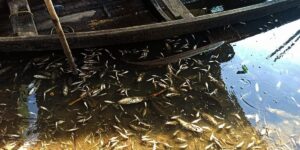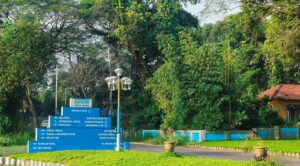Areas like the Eloor Depot, Manjummel, and Udyogamandal are shrouded in this heavy, opaque haze. The Periyar, Kerala’s longest river, reflects the cost of this unchecked industrialisation. In some stretches near Eloor, the river flows in shades of red or black, stained by chemical waste.
Published Dec 08, 2024 | 9:00 AM ⚊ Updated Dec 18, 2024 | 11:50 AM

The lab reports regarding Eloor’s air and water quality have revealed shocking findings, exposing the presence of chemical toxins that are hazardous to both human health and the environment.
In Kerala’s December mornings, mist often lends an air of serenity to the landscape. But in Eloor, a suburb of Kochi, what might seem like a picturesque fog to an outsider is, in reality, dense smog — a toxic blend of pollutants released by the numerous factories crammed into this industrial hub.
Areas like the Eloor Depot, Manjummel, and Udyogamandal are shrouded in this heavy, opaque haze. The Periyar, Kerala’s longest river, reflects the cost of this unchecked industrialisation. In some stretches near Eloor, the river flows in shades of red or black, stained by chemical waste.
Decades of public outcry have not made much difference. Activists continue their fight in the High and Supreme Courts, but meaningful action remains elusive, leaving the residents of Eloor trapped in a toxic environment.
Residents of Eloor municipality, as well as those living in parts of nearby Kalamassery, Tripunithura, and Thrikkakara, bear the constant assault of pollution; smog and foul odour, in recent weeks, have taken up permanent residence in these neighbourhoods.

Philomina
Smoke and black dust coats homes, making breathing difficult. Children and the elderly are especially affected.
Municipal authorities and the Pollution Control Board (PCB) have been slow to regulate the 340 industrial units in the neighboring Edayar industrial area.
Philomina, a resident of Eloor, told South First, “We are grappling with severe health issues such as breathing difficulties, asthma, and skin diseases. Both my grandchildren suffer from breathing problems. Just two days ago, we had to rush them to Najath Hospital in Aluva, where they were admitted. At times, the river water changes colour, and the toxic environment has led to mass fish deaths. We live in constant uncertainty, not knowing what will happen tomorrow.”
“The report submitted by the committee appointed by the Kerala High Court regarding the Periyar pollution and the unprecedented fish kill on 20 May 2024, is misleading and defies basic human logic. The Pollution Control Board (PCB) has manipulated facts to protect the interests of companies responsible for the pollution,” said Purushan Eloor, a prominent environmental activist from Eloor.

Purushan Eloor
The Kerala High Court had tasked a committee comprising Dr. Rathan U Khelkar IAS (Environment Secretary), J. Chandrababu (Regional Director, CPCB), Sunil Pameedi IFS (Director, Environment and Climate Change), and Sreekala (Chairperson, PCB) to investigate the pollution and fish kill and submit a comprehensive report.
Additionally, activists like Purushan Eloor, KSR Menon, and Shibu Manuel were permitted to accompany the committee during sample collection and analysis.
“Despite collecting 23 sediment and water samples from different parts of the Periyar, the PCB’s report conveniently omitted critical findings that highlight the presence of highly toxic substances. The samples, divided between the PCB and activists, were tested at accredited labs. The activists’ tests revealed alarming levels of mercury, arsenic, cadmium, and hexavalent chromium — far exceeding permissible limits. However, the PCB’s report downplayed or outright ignored these findings, which is a blatant attempt to mislead the court,” Purushan added.
The Kuzhikandam creek in Eloor is counted among the most polluted waterbodies in the state, third-most polluted in the country and 35th in the world, according to Greenpeace. In 2011, under the National Clean Energy Fund programme, the creek was identified for remediation by the Ministry of Environment and Forests.

Kuzhikandam Creek
Pesticides, heavy metals and industrial effluents have been polluting the creek, and in July this year, a team of researchers from Cochin University of Science and Technology found alarming levels of an insecticide called Chlorpyrifos.
Purushan, the activist cited earlier, said the ongoing battle against pollution in the Periyar and the National Green Tribunal’s 2022 directive to scientifically clean the Kuzhikandam creek within a year have not yielded the desired results.
“PCB colluded with the Eloor municipality in an unauthorised dredging of the canal in July 2023, which activists successfully halted. Subsequent, joint sampling confirmed the presence of dangerous pesticides like DDT, refuting PCB’s earlier claims of no contamination,” Purushan said.
The fish kill of 20 May was attributed to organic waste, an outdated argument that ignores the actual cause — industrial pollutants, Purushan said.
“CMFRI’s postmortem findings and the PCB’s own test results on our behalf were conveniently left out of the final report. This omission reeks of a conspiracy to shield the polluters,” he alleged.
The lab reports regarding Eloor’s air and water quality have revealed shocking findings, exposing the presence of chemical toxins that are hazardous to both human health and the environment.

Fish found dead due to toxic chemicals in Periyar.
The data collected by activists highlights dangerous levels of heavy metals, industrial chemicals, and pesticides.
These contaminants not only violate permissible limits but also threaten the ecosystem and public well-being.
Mercury: Detected at 7 locations near TCC, with concentrations ranging from 1.51 mg/kg to 22.42 mg/kg (permissible limit: 0.05 mg/kg).
Arsenic: Found in 19 locations, ranging from 1.41 mg/kg to 73.86 mg/kg (permissible limit: 0.01 mg/kg).
Cadmium: Present in 12 locations, ranging from 1.96 mg/kg to 37.38 mg/kg (permissible limit: 0.001 mg/kg).
Hexavalent Chromium: Detected in all samples, with levels ranging from 7.67 mg/kg to 628.50 mg/kg (permissible limit: 0.1 mg/kg).
Ammoniacal Nitrogen: Found near industries like FACT and TCC, with concentrations ranging from 311.97 mg/kg to 365.15 mg/kg. These levels are depleting oxygen in water, causing widespread fish kills.
pH Levels: Measured as low as 4.32 near FACT’s rainwater outlet, indicating high acidity in the water.
Pesticides
DDT and Derivatives: Found near the Hindustan Insecticides Limited (HIL) outlet in Kuzhikandam stream, with the following concentrations:
DDT: 179 mg/kg
OP-DDT: 179 mg/kg
DDE: 50.5 mg/kg
DDD: 254 mg/kg
Total: 412 mg/kg
“These findings not only expose the Pollution Control Board’s repeated malpractice in testing and reporting but also suggest a larger conspiracy to protect polluting industries at the cost of human health and environmental safety,” Purushan said.
When South First reached out to residents in the Eloor area, many were too fearful to speak about their suffering.

FACT, Eloor
One resident, Sathi (name changed), cautiously agreed to share her experience, but on the condition that the news would not affect their lives because her husband is a contract worker at Fertilizers and Chemicals Travancore Limited (FACT) in Eloor.
She revealed harrowing details: “We fear speaking out because many of us depend on the factories here — fertilizer plants, bone powder processing, chicken waste processing, cowhide industries, and rubber factories. I moved here 19 years ago after marriage.
Now, I am suffering from asthma, and so are my children. They also have skin diseases. The muscle pain is unbearable. In this area, there are so many cancer patients. It’s impossible to find a household without someone who is ill.”
She remembered the victims of endosulfan poisoning in Kasaragod district. “Here in Eloor, we also have children suffering from similar disabilities, enduring in silence for decades. Genetic disorders threaten our next generation.”
While the adults are silenced by the fear repercussion, the children speak of the pain of pollution openly, thanks to environmental awareness classes they attend in school.
Sachin from GHS Muppadathom and Devaraj from SHJUP School Eloor shared their experience with South First.
“Sometimes, we see smog in the air at night, and we feel irritation in our eyes and have trouble breathing. In school, we have a Haritha Sabha that taught us the importance of going green. We don’t know exactly what to do, but we understand that these big factories are killing us every day,” they said.
In Eloor, a region home to 326 industries, both large and small, South First’s investigation revealed a stark reality about the local employment situation.
Despite the vast number of factories, only 6,000 residents of Eloor are employed across these industries, meaning each panchayat ward barely sees four workers from the local community.
The majority of the workforce consists of contract labourers, with numbers ranging from 200 to 300.
The shocking truth is that most of the jobs in Eloor are taken by workers from North India, willing to work for as little as ₹650 per day.
This disparity stretches all the way to the management level, where individuals from North India take home large sums in salaries, contributing to a clear North-South divide.
This division is visible not only in employment but also in the handling of corporate social responsibility (CSR).
Most companies, managed by North Indian individuals, prefer to direct their CSR funds toward villages in their home states, rather than invest in Eloor.
This neglect is compounded by the environmental degradation in the region, where toxic chemicals are buried underground, posing long-term health risks to the local population.
The sole benefit the people of Eloor receive from these industries is free drinking water for 3,000 families, a hard-fought achievement after years of struggle.
Companies like Indian Rare Earth Limited (IRE), The Fertilizers and Chemicals Travancore Limited (FACT), HIL, and Berkan provide this service through funds set aside by polluter pays principle, not as part of their CSR initiatives.
However, such a facility becomes a service only when drinking water, freely available in nature, becomes a rare commodity.
The only real CSR activity in the region consists of a library and a waiting shed provided by IRE.
Biju Kumar, a resident of Eloor, expressed his concerns: “We know what awaits us. One day, we may meet the same fate as the fish in the Periyar River, poisoned by hazardous chemicals. Just like Bhopal, we might die from the same toxic forces, but there’s nothing we can do about it. Even Supreme Court directives are being violated here. So what difference will our protests make? Until the corrupt politics of bribery end, nothing will change. These companies contribute enormous funds to the government, and that’s why they are treated with favour. That’s the simple truth.”
The people of Eloor know that they are living in a place that could very well become tomorrow’s Pripyat, the Ukrainian city that was evacuated on 27 April 1986, a day after the Chernobyl disaster.
(Edited by Rosamma Thomas).
